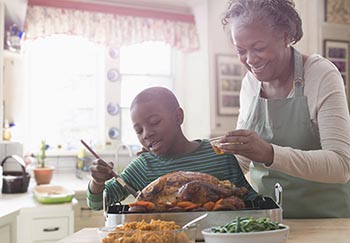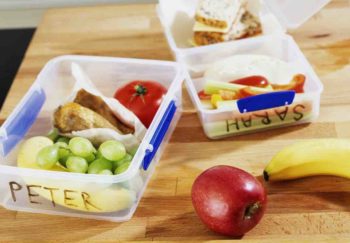
If you aren’t used to cooking for someone with food allergies, it can be daunting to find out that a holiday guest has them. And with 32 million Americans having food allergies, including 1 in 13 children, chances are good you’ll have to consider allergy-free cooking at some point. You might also cook for individuals with other reactions, such as a gluten sensitivity or lactose intolerance.
Common Food Allergies, Sensitivities and Intolerances
The most common triggers include:
- Wheat (gluten)
- Milk
- Eggs
- Soy
- Peanuts
- Tree nuts, such as almonds and cashews
- Shellfish
- Fish
You can be allergic, sensitive or intolerant to any of these foods. The terms aren’t interchangeable. Allergies and sensitivities both cause an immune system response, but they involve different mechanisms, explains dietitian Katie Osterlund, who works with kids and hospitalized adults at UVA.
Allergies cause a more severe reaction, but allergies and sensitivities both cause at least some anaphylaxis symptoms, which include:
- Rashes
- Swelling
- Throat closure
- Trouble breathing
Anaphylaxis can be life-threatening, and people at risk will probably be prescribed an EpiPen or another epinephrine injector.
With an intolerance, on the other hand, the body lacks the enzyme it needs to digest the food. Food intolerance symptoms include diarrhea, gas, stomachaches and other digestive problems.
Avoiding Food Allergic Reactions at Thanksgiving
If your child or spouse has a food allergy, sensitivity or intolerance, avoiding accidental exposure is a necessary part of your life. But if you’re trying to accommodate guests at an occasion like a holiday meal or party, you may be unsure how to guarantee their safety.
Food Allergy Resources
Read ingredient labels carefully
Per FDA laws, food labels must state in plain English if the food contains one of the top eight allergens. But some foods aren’t covered under the law, so become familiar with other terms for allergens. For example, semolina is a type of wheat.
Don’t Cross Contaminate
Use separate cookware, dishes and utensils for foods containing allergens. Wash your hands thoroughly after handling allergens.
Clean Surfaces Carefully
With more severe allergies and sensitivities, even coming into contact with a contaminated surface can cause a reaction. Clean counters and tables carefully, starting before the person with the allergy arrives at your house. Soap and water or any cleaner is OK, Osterlund says.
Think You Have a Food Allergy?
Make an appointment with a Charlottesville allergist.
Use Substitutes
If someone’s at risk for a life-threatening anaphylactic reaction, don’t take that chance! Avoid cooking with that food item, and try new allergy-free recipes or use substitutes. Osterlund recommends these substitutes:
- Milk — soy milk, which has a comparable amount of protein to cow’s milk, or rice and oat milks. All cook well.
- Eggs — mashed banana or applesauce in baked goods such as cookies. They have similar binding abilities.
- Wheat flour — corn flour, rice flour or oat flour.


One of the best issues that you can do before and after your massage is usually to consume a lot of h2o. your massage therapy would be to ingest lots of h2o, one of the best things that can be done . Water can help you to eradicate a few of the free radicals that are in your body, which might be leading to your pain to begin with. This may enhance your current encounter.
Pre and post your restorative massage is to drink a great deal of water, among the finest points you can do . H2o will help you to get rid of some of the free radicals that happen to be in your body, which is often triggering your discomfort in the first place. This will enhance your general expertise.